Abstract
Manii (Maesopsis minii) is a fast-growing wood that is mainly produced for light construction and woodworking. The wood has low durability properties and requires improvements in quality. This research aims to evaluate the combination effect of boric acid, seed oil, and heating on the color of manii wood and its resistance against subterranean termites and decay fungi. The wood samples were modified by combining boric acid, neem oil, tamanu oil, and candlenut oil and heating at 70 °C and 140 °C for 4 h. The color change in the wood was evaluated using the CIELab method, while the resistance against subterranean termites (Coptotermes curvignathus) and decay fungi (Schizophyllum commune) was tested according to the SNI 7207-2014 standard. The results show that a significant color change occurred after the oil treatments. L and b values generally decreased, while the a values usually slightly increased after treatment. Boric acid significantly increased the resistance of manii wood against tested termites and fungi. The seed oils also improved wood resistance against termites, while the wood resistance against fungi significantly improved from the combination of boric acid and seed oil treatment. The lowest weight loss in termite and fungal tests occurred with the combination of boric acid and candlenut oil with heating at 140 °C.
1. Introduction
Manii wood (Maesopsis eminii Engl.) is a fast-growing species planted in many community forests in West Java [1]. Manii wood is mainly used for construction and wood working. Its texture is coarse with interlocked grains that produce a clear figure on board surfaces [2]. This fast-growing wood has a high productivity rate with an air-dry density of 0.39 g.cm3 [3], specific gravity of 0.42, and a strength class of III, but its durability is low (durability class V) [4]. Thus, the wood is easily attacked by degrading organisms when it is used. This is a critical problem of fast-growing wood in structural utilization.
The preservation of fast-growing woods, especially with environmentally friendly techniques, is becoming more important. Boron compounds are well-known preservatives that can control fungal attacks [5] and insects [6]. However, boron preservatives are easily leached by water. Therefore, this preservative cannot be optimally used for exterior functions [7]. To solve this leaching problem, boron preservatives need to be combined with other materials or treatments. Combining boron preservatives with oil could reduce preservative leaching by water [8] and significantly improve decay resistance [9]. Plant oil treatment increases the hydrophobicity of wood [10] and reduces the wettability of the wood’s surface [11].
The combination of boron with natural preservatives might increase the effectiveness of the wood’s protection from destructive organisms. Natural preservatives extracted from plants have a pesticide effect, but are safe for humans and the environment. Some potential natural preservatives that have anti-termite effects are tamanu (Calophyllum inophyllum) [12], Azadirachta indica [13], and candlenut (Aleurites moluccana (L.) Willd) oils [14]. Heat treatment is an environmentally friendly method for protecting wood against various decay fungi [15]. Heat treatment at 200 °C significantly decreases equilibrium moisture content and density, and significantly improves the water-reabsorbing capacity and dimensional stability of poplar (Populous sp.) wood, while the darkening effect on wood can produce more desirable, highly aesthetic color tones and achieve color uniformity [16]. Heating the spruce wood at or above 200 °C resulted in greater resistance against brown-rot fungus Serpula lacrymans than white-rot fungus Trametes versicolor [17]. However, heat treatments did not protect wood in a field test against subterranean termites. The combination of thermal (180 and 200 °C) and organosilane treatments significantly improved the durability of pine wood against Coniophora puteana as well as against the micro-fungi [18]. Combining heat treatment at 200 °C with 75% neem and 25% sesame oil significantly reduced subterranean termite attacks [19]. The combination of boric acid and chitosan treatments followed by heating at 140 °C considerably improved the resistance of Maesopsiss eminii wood against white-rot fungi (Schizophyllum commune), dry-wood termites (Cryptotermes cynocephalus), and subterranean termites (Coptotermes curvignathus) [20]. Linseed oil treatment resulted in the best improvement in wood resistance against Odontotermes obesus termites, followed by neem, jatropha, jojoba, and eucalyptus oils [21]. Oil heating can also improve wood’s dimensional stability and increase its resistance to fungi and termites [22].
The study of the synergetic effects of natural oils in efforts to improve boron preservatives would be developed as an eco-friendly preservation technique. Therefore, this study aims to evaluate the combination effect of boric acid, seed oil, and heating on the color of manii wood (M. eminii) and its resistance to subterranean termites and decay fungi.
2. Materials and Methods
Manii logs (M. eminii), including those made of heartwood and sapwood, with an average diameter of 38 cm obtained from a sawmill industry in Bogor were sawn into several 3 cm-thick boards. The boards were dried at 50 °C in an experimental kiln with a capacity of 1 m3 to a moisture content of ±14%. Some test samples were then produced in various sizes according to Table 1.

Table 1.
The size of the test samples.
The impregnation of boric acid or seed oil was conducted in a preservation tank at a pressure of 7 kg.cm−2 for 4 h. The combination of wood treatments is described in Table 2. All tests were conducted in 5 replications. The impregnants in this research were 5% boric acid, neem oil (Azadirachta indica), tamanu oil (Calophyllum inophylum L.), and candlenut oil (Aleurites moluccana). The following heat treatment was conducted in a laboratory heating oven, “Memmert,” at 70 °C or 140 °C under atmospheric pressure for 4 h.

Table 2.
Treatment combinations used with manii wood.
The retention of boric acid was calculated after the first impregnation with Equation (1). After the oil impregnation, the weight percent gain (WPG) value was determined by Equation (2).
Here,
Wo = sample weight before boric acid impregnation (kg);
Wt = sample weight after boric acid impregnation (kg);
V = sample volume (m3);
C = preservative concentration (%);
WPG = weight percent gain (%);
Wh = sample weight before oil treatment (g);
Wb = sample weight after oil and heat treatments (g).
The color of the wood was evaluated before and after treatments using a CanoScan 4400F scanner. The wood image was analyzed using the CIELab method that determined L*a*b values at three different points on the sample’s surface using Adobe Photoshop CS3 application. Parameter L* indicated light (+) or dark (−), a* indicated reddish (+) or greenish (−), and b* indicated yellowish (+) or bluish (−) [23] colors. The changes in L*, a*, and b*, (ΔL, Δa, and Δb, respectively) were calculated using Equations (3)–(5). The color change (ΔE) was then calculated using Equation (6).
ΔL = L1 − L0
Δa = a1 − a0
Δb = b1 − b0
ΔE = [(ΔL)2 + (Δa)2 + (Δb)2]1/2
Here, L1, a1, and b1 are the values of L*, a*, and b*, respectively, after wood treatments, while L0, a0, and b0 are the values before the treatments [24]. The color change (ΔE) was classified according to Table 3.

Table 3.
Classification of color change (ΔE).
The resistance test against subterranean termites and decay fungi was evaluated based on the modified SNI 7207:2014 standard [26]. Prior to testing, the wood samples were oven-dried at 70 °C to a constant weight.
The non-choice testing method against subterranean termites involved a wood sample that was placed in a test bottle, leaning on its wall. Moisturized sand (±200 g) at a moisture content of 5% below its water holding capacity was added to the bottle. Then, 200 healthy and active subterranean termites (Coptotermes curvignathus Holmgren) were placed into each bottle and covered with fine, perforated plastic. The wood’s exposure to termites was performed in a dark room at ±28 °C. After 4 weeks of exposure, the samples were removed from the bottle, cleaned of sand, and oven-dried at 70 °C to a constant weight. The wood’s weight loss was calculated using Equation (7). The wood’s resistance against subterranean termites was classified based on Table 4.

Table 4.
The resistance class of wood against subterranean termites.
Here,
WL = weight loss (%);
W0 = dry weight of the sample before the test (g);
W1 = dry weight of the sample after the test (g).
The wood resistance test against decay fungi used Schizophyllum commune on PDA (potato dextrose agar) media. After 12 weeks of the decay test at room temperature (±28 °C), the sample was cleaned from mycelium and oven-dried at 70 °C to a constant weight. The weight loss of the wood was calculated using Equation (7). The wood’s resistance against the decay fungi was classified based on Table 5.

Table 5.
Wood’s resistance against decay fungi.
The effect of boric acid, seed oil, and heating on the color change on and resistance of manii wood against subterranean termites and decay fungi was statistically analyzed using a factorial, completely randomized design. Factor A had 2 levels (boric acid and no boric acid). Factor B had 4 levels (neem oil, tamanu oil, candlenut oil, and no oil). Factor C had 2 levels (70 and 140 °C). The Duncan test was then performed if the results of the analysis of variance (ANOVA) had a significant effect at a 95% confidence interval.
3. Results and Discussion
Manii (M. eminii Engl.) wood has a color that combines white sapwood and yellowish heartwood when freshly cut, and turns golden brown or dark brown when dry and exposed to the environment [2]. The texture of the wood is moderately coarse and even, with interlocked grains that produce a clear figure on quarter-sawn surfaces. Figure 1 shows that without oil and boric acid treatments, manii wood has different colors in the 70 °C and 140 °C heat treatments: slightly darker at 140 °C (AT140) than at 70 °C (AT70). This supports the previous report [27] that heat treatment reduces the lightness (L) of oak, birch, and pine woods.
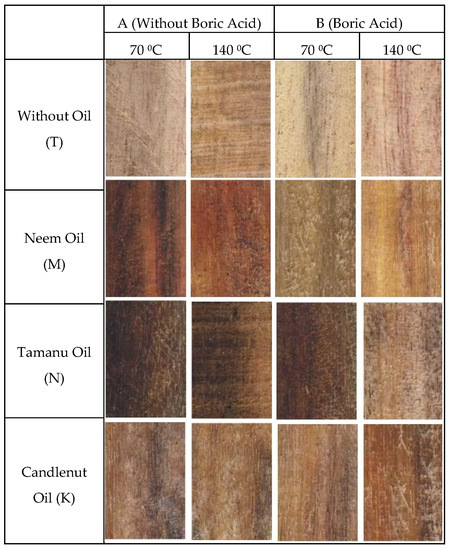
Figure 1.
The appearance of manii wood after heating at 70 or 140 °C, and treatments with boric acid (B), without boric acid (A), with neem oil (M), with tamanu oil (N), with candlenut oil (K), and without oil (T).
Boric acid treatment (BT70 and BT140) led to a brighter wood than treatments without boric acid (AT70 and AT140). However, in previous research, borate preservation darkened Scots pine and Oriental beech woods [28]. In general, all oil treatments (neem, tamanu, and candlenut) significantly changed the wood’s appearance compared to treatments without oil. This is supported by the fact that the L values, in Figure 2, in all oil-treated woods, were less than 42 (darker), while untreated-oil woods showed L values of more than 56 (brighter). This is in accordance with Dubey et al. [29], who showed that oil heating resulted in a more uniform and darker color of Pinus radiata wood. Comparing oil treatments, tamanu oil showed a lower L value (darker) than neem and candlenut oils. Heating at 140 °C slightly increased the a and b values of manii wood, which became more reddish and yellowish. Similarly, boric acid treatment also caused a slight increase in the a and b values. On the other hand, oil treatments mostly resulted in increased a values but reduced b values, which represents more reddish and less yellowish hues than in treatments without oil. Figure 1 shows that all treated manii wood samples still had clear, attractive, natural features, although in different colors.
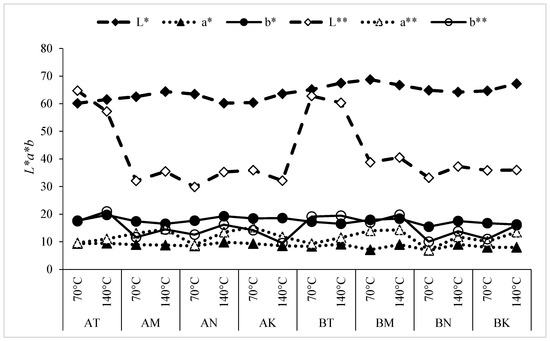
Figure 2.
The L*a*b values of manii wood after heating at 70 or 140 °C, and treatments with boric acid (B), without boric acid (A), with neem oil (M), with tamanu oil (N), with candlenut oil (K), and without oil (T).
Figure 3 shows that the greatest color change (ΔE) occurred in the treatment with tamanu oil and 70 °C heating (AN70). All oil treatments caused significant color changes (ΔE greater than 25), five times higher than those of treatments without oil (AT70). As a comparison, the color changes (ΔE) in oil-heated Korean pine wood at 200 °C and 180 °C were about 30.0 and 18.4, respectively [30]. According to Cui et al. [25], a color change (ΔE) of more than six was categorized as very appreciable, which occurred in all treatments in this experiment. Heating at 140 °C caused a greater color change than heating at 70 °C, except in neem and tamanu oil treatments, which reduced the color change. The analysis of variance revealed the interaction effect of oil treatment and heating temperature on the color change (ΔE) in manii wood (Table 6). Furthermore, the Duncan test (Table 7) showed that, in the tamanu oil treatment, heating at 140 °C led to a color that was significantly different from that caused by heating at 70 °C, while in the neem and candlenut oil treatments, the color differences were not significant. Tamanu oil with 140 °C heating caused a 24% less color change compared with 70 °C heating.
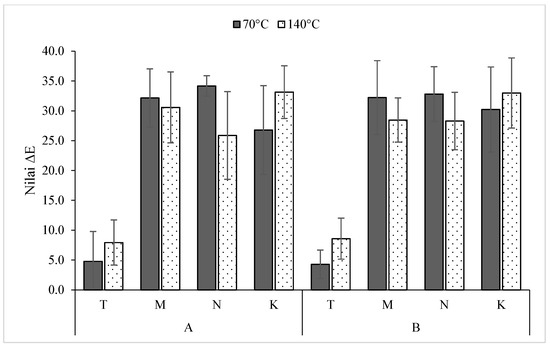
Figure 3.
Color change (ΔE) in treated manii wood with heating at 70 or 140 °C and with boric acid (B), without boric acid (A), with neem oil (M), with tamanu oil (N), with candlenut oil (K), and without oil (T).

Table 6.
Compilation of analyses of variance (ANOVA).

Table 7.
The Duncan test for color change (ΔE).
The resistance test against subterranean termites (C. curvignathus) revealed that all treated manii woods lost less weight than the control sample (AT70) (Figure 4). The control sample showed an 11.54% weight loss due to subterranean termites. Based on the SNI 7207-2014 standard, this untreated manii was classified as Resistance Class IV (low resistance). Its deviation standard was high because the sample came from heartwood and sapwood manii woods. In general, heartwood contains more extractives than sapwood, which affects the wood’s durability against biodeterioration agents. França et al. [31] similarly reported that heartwoods, compared to sapwood, of Khaya ivorensis and K. senegalensis were more resistant to decay fungi and subterranean termites.
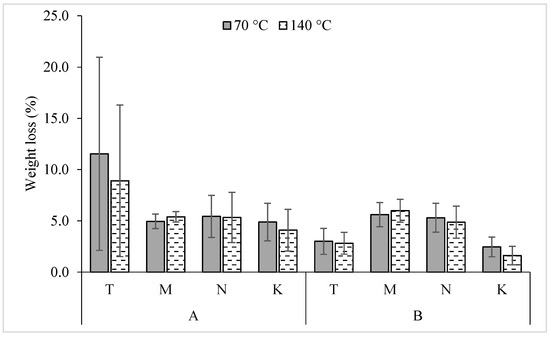
Figure 4.
Weight loss of manii wood in the subterranean termite test after heating at 70 or 140 °C and treatments with boric acid (B), without boric acid (A), with neem oil (M), with tamanu oil (N), with candlenut oil (K), and without oil (T).
Boric acid significantly reduced the weight loss of manii wood, such that it was very resistant (Resistance Class I) against subterranean termites. The analysis of variance revealed that boric acid and oil treatments had a significant interaction effect at a 95% confidence interval on weight loss in the subterranean termite test (Table 6). Furthermore, the Duncan test revealed that boric acid treatment (BT) had a significantly lower weight loss than the untreated wood (AT) (Table 8). Boric acid is a well-known chemical insecticide [32] and has been mainly used for interior functions.

Table 8.
Duncan test of weight loss due to subterranean termites.
Treatments with neem, tamanu, and candlenut oils (AM, AN, and AK, respectively) caused significantly less weight loss than treatments without oil (AT). All oil treatments increased the resistance against subterranean termites to Class II. These seed oils contained some substances that had biological activities and could be used for wood protection. Tamanu oil contains flavonoids, alkaloids, and saponins [33]. Neem oil contains tannins, flavonoids, alkaloids, steroids, saponins, and triterpenoids [34]. Candlenut oil contains saponins, alkaloids, phenolics, glycosides, flavonoids, and triterpenoids [35]. Flavonoids have antifungal and termiticidal effects [36]. Alkaloids have strong anti-termite and repellant activities against subterranean termites Odontotermes obesus [37]. Saponins exhibit notable insecticidal effects against Rhyzopertha dominica and Tribolium castaneum [38].
Combining neem or tamanu oils with boric acid could not cause greater resistance against subterranean termites than boric acid treatment (BT70). On the other hand, the combination of boric acid and candlenut oil with heating at 140 °C (BK140) caused less weight loss than boric acid treatment (BT70). BK140 had the least weight loss in this experiment. Heating at 140 °C reduced weight loss in the AT treatment (without boric acid and oils) and in the candlenut oil treatment (AK and BK). Compared to the control, heating at 140 °C increased the resistance class from IV (low resistance) to III (moderate resistance). A previous study showed that the effect of heat treatment on the resistance against termites varied between wood species and treatments. Heat treatment at 180 °C did not improve the resistance of spruce and Scots pine woods against termites. However, the termite resistance of Scot pine increased after heating at 210 °C [39].
Figure 5 shows the weight loss of wood in the resistance test against decay fungi (S. commune). Untreated manii wood showed an 11.3% weight loss that was classified as a low-resistance class (class IV) according to the SNI 7207-2014 standard. Therefore, preservation was strongly recommended for the use of manii wood, mainly for structural function. This decay test showed that the weight loss of manii wood decreased by 17% following boric acid treatment, which indicated an increase in the wood’s resistance against decay fungi to Class III. Moreover, the combination of boric acid and all seed oils caused the wood’s weight loss to range from 8.1% to 5.8%, which indicated a synergetic effect between boric acid and seed oil. The analysis of variance (ANOVA) (Table 6) showed that boric acid and oil had a significant interaction effect on the weight loss of manii wood. A single treatment of neem, tamanu, or candlenut oils did not produce a substantial effect on the weight loss of manii wood. However, when the seed oils were combined with boric acid, the weight loss of the manii wood was significantly less than that under treatment with boric acid alone. As revealed in the Duncan test (Table 9), boric acid–neem oil (BM), boric acid–tamanu oil (BN), and boric acid–candlenut oil (BK) treatments had significantly less weight loss than the treatment with boric acid alone (BT). Boric acid–candlenut oil treatments (BK) caused the least weight loss of manii wood in this research, which was 37% less than the BT treatment and 45% lower than the untreated sample (AT).
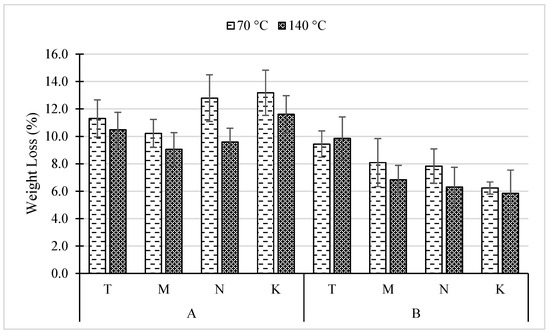
Figure 5.
Weight loss of manii wood in the decay test after heating at 70 or 140 °C and treatments with boric acid (B), without boric acid (A), with neem oil (M), with tamanu oil (N), with candlenut oil (K), and without oil (T).

Table 9.
Duncan test of weight loss due to decay fungi.
Tamanu oil contains saponins that have anti-fungal effects [40]. Neem oil effectively inhibits the growth of Trichophyton mentagrophytes [41]. The anti-fungal substances in neem oil are tannins and triterpenoid. Tannins are efficacious in suppressing brown-rot fungi [42], while triterpenoid can degrade cell organelles and inhibit the growth of pathogenic fungi [43]. Candlenut oil has flavonoids that can inhibit cell division, disrupt mitotic function, and inhibit fungal growth [44].
A statistical analysis also revealed that heating at 140 °C resulted in significantly fewer fungal attacks, as indicated by the lower weight loss of manii wood than that of heating at 70 °C. In a previous study, heat treatment at 210 °C increased the resistance against various fungi of Scots pine (Pinus sylvestris) and spruce (Picea orientalis) [39]. The changes in the wood’s chemical composition due to heating can affect the resistance against decay fungi; hemicellulose content markedly decreases as temperature and heating duration increases [15].
4. Conclusions
The effect of combining boric acid, neem oil, tamanu oil, and candlenut oil and of heating (at 70 and 140 °C) showed some improvement in wood’s resistance against subterranean termites and decay fungi. Oil treatment and heating at 140 °C produced darker and more even colors in the manii wood, while the wood’s features were still clearly observable. L and b values generally decreased, while a values slightly increased after treatment. Boric acid increased the resistance of the manii wood against tested termites and decay fungi, while the seed oil treatments improved the resistance against termites. The combination of boric acid and seed oil significantly improved the wood’s resistance against decay fungi. Heating at 140 °C also resulted in wood that was more resistant against decay fungi. The lowest weight loss in the termite and fungal tests occurred with the combination of boric acid and candlenut oil and with heating at 140 °C.
Author Contributions
Conceptualization, supervision, and writing, T.P.; investigation, J.K.; data analysis, I.P.K.; project administration, Tina Agustin. All authors have read and agreed to the published version of the manuscript.
Funding
This research and APC were funded by a collaborative research program of the Directorate General of Higher Education, Research and Technology, the Ministry of Education, Culture, Research and Technology (DITJEN DIKTIRISTEK) and the Institute for Research and Community Services (LPPM), IPB University No 082/E5/PG.02.00.PT/2022.
Institutional Review Board Statement
Not applicable.
Informed Consent Statement
Not applicable.
Data Availability Statement
The data was resulted in this research.
Acknowledgments
We would like to thank the Directorate General of Higher Education, Research and Technology, the Ministry of Education, Culture, Research and Technology (DITJEN DIKTIRISTEK) for research funding. We are also very grateful to the Institute for Research and Community Services (LPPM), IPB University, which has facilitated the implementation of this research in a good and useful way.
Conflicts of Interest
The authors declare no conflict of interest.
References
- Effendi, R. Kajian tata niaga kayu rakyat di Pulau Jawa Bagian Barat. J. Penelit. Hutan Tanam. 2011, 8, 251–258. [Google Scholar] [CrossRef][Green Version]
- Ani, S.; Aminah, H. Plantation timber of Maesopsis eminii. J. Trop. For. Sci. 2006, 18, 87–90. [Google Scholar]
- Sadiyo, S.; Susanto, D.; Pratiwi, N.E.S. Nilai kekuatan tumpu baut pada empat enis kayu rakyat Indonesia. J. Tek. Sipil 2017, 24, 153–158. [Google Scholar] [CrossRef]
- Muslich, M.; Rulliaty, S. The resistance of 45 Indonesian wood species against dry-wood termites and subterranean termites. J. Penelit. Has. Hutan 2016, 34, 51–59. [Google Scholar] [CrossRef]
- Erper, I.; Yıldırım, E.; Türkkan, M. Antifungal effect of boron compounds against three Rhizoctonia solani AG-4 subgroups causing root and crown rot. Gesunde Pflanz. 2019, 71, 61–71. [Google Scholar] [CrossRef]
- Sarwar, M. Inorganic insecticides used in landscape settings and insect pests. Chem. Res. J. 2016, 1, 50–57. [Google Scholar]
- Ghani, R.S.M. A review of different barriers and additives to reduce boron movement in boron dual treated wood. Prog. Org. Coatings 2021, 160, 106523. [Google Scholar] [CrossRef]
- Tomak, E.D.; Hughes, M.; Yildiz, U.C.; Viitanen, H. The combined effects of boron and oil heat treatment on beech and Scots pine wood properties. Part 1: Boron leaching, thermogravimetric analysis, and chemical composition. J. Mater. Sci. 2010, 46, 598–607. [Google Scholar] [CrossRef]
- Tomak, E.D.; Viitanen, H.; Yildiz, U.C.; Hughes, M. The combined effects of boron and oil heat treatment on the properties of beech and Scots pine wood. Part 2: Water absorption, compression strength, color changes, and decay resistance. J. Mater. Sci. 2010, 46, 608–615. [Google Scholar] [CrossRef]
- Arminger, B.; Jaxel, J.; Bacher, M.; Gindl-Altmutter, W.; Hansmann, C. On the drying behavior of natural oils used for solid wood finishing. Prog. Org. Coat. 2020, 148, 105831. [Google Scholar] [CrossRef]
- Tomak, E.D. Surface wettability of boron and oil-treated wood. Cerne 2022, 28, e103058. [Google Scholar] [CrossRef]
- Adegoke, O.A.; Ajala, O.O.; Alamu, A.J. Anti-termite effectiveness of Calophyllum inophyllum Linn. Seed oil on selected tropical wood species. In Proceedings of the XIV World Forestry Congress, Durban, South Africa, 7–11 September 2015. [Google Scholar]
- Okanlawon, F.B.; Adegoke, O.A.; Olatunji, O.A.; Okon-Akan, O.A.; Akala, A.O. Effectiveness of Azadirachta indica A. Juss (neem) seed oil in controlling wood termite. J. Appl. Sci. Environ. Manag. 2020, 24, 1541–1544. [Google Scholar] [CrossRef]
- Nakayama, F.; Osbrink, W. Evaluation of kukui oil (Aleurites moluccana) for controlling termites. Ind. Crop. Prod. 2010, 31, 312–315. [Google Scholar] [CrossRef]
- Yalçin, M.; Ibrahim, H. Changes in the chemical structure and decay resistance of heat-treated narrow-leaved ash wood. Maderas. Cienc. Y Tecnol. 2015, 17, 435–446. [Google Scholar] [CrossRef]
- Kamperidou, V.; Barboutis, I.; Vasileiou, V. Effect of thermal treatment on colour and hygroscopic properties of poplar wood. In Proceedings of the 23rd International Scientific Conference: Wood is Good—With Knowledge and Technology to a Competitive Forestry and Wood Technology Sector, Proceedings, Zagreb, Croatia, 12 October 2012; pp. 59–67. [Google Scholar]
- Vidholdová, Z.; Kačík, F.; Reinprecht, L.; Kučerová, V.; Luptáková, J. Changes in chemical structure of thermally modified spruce wood due to decaying fungi. J. Fungi 2022, 8, 739. [Google Scholar] [CrossRef] [PubMed]
- Kamperidou, V. The biological durability of thermally- and chemically-modified black pine and poplar wood against basidiomycetes and mold action. Forests 2019, 10, 1111. [Google Scholar] [CrossRef]
- Fatima, Z.; Ahmed, S.; Hassan, B. Combined effects of neem (Azadirachta indica) and sesame (Sesamum indicum) oil as a wood preservative on subterranean termites in the field. Maderas. Cienc. Tecnol. 2021, 23, 1–8. [Google Scholar] [CrossRef]
- Istriana, N.; Priadi, T. The resistance of modified manii wood with boric acid and chitosan/glycerol and heating against fungi and termites. IOP Conf. Series Earth Environ. Sci. 2021, 891, 012010. [Google Scholar] [CrossRef]
- Ahmed, S.; Fatima, R.; Hassan, B. Evaluation of different plant derived oils as wood preservatives against subterranean termite Odontotermes obesus. Maderas. Cienc. Y Tecnol. 2020, 22, 109–120. [Google Scholar] [CrossRef]
- Lee, S.H.; Ashaari, Z.; Lum, W.C.; Halip, J.A.; Ang, A.F.; Tan, L.P.; Chin, K.L.; Tahir, P.M. Thermal treatment of wood using vegetable oils: A review. Constr. Build. Mater. 2018, 181, 408–419. [Google Scholar] [CrossRef]
- Cao, S.; Cai, J.; Wu, M.; Zhou, N.; Huang, Z.; Cai, L.; Zhang, Y. Surface properties of poplar wood after heat treatment, resin impregnation, or both modifications. Bioresources 2021, 16, 7562–7577. [Google Scholar] [CrossRef]
- Hidayat, W.; Qi, Y.; Jang, J.H.; Park, B.H.; Banuwa, I.S.; Febrianto, F.; Kim, N.H. Color change and consumer preferences towards color of heat-treated Korean white pine and royal paulownia woods. J. Korean Wood Sci. Technol. 2017, 45, 213–222. [Google Scholar] [CrossRef]
- Cui, W.; Kamdem, P.; Rypstra, T. Diffuse reflectance infrared fourier transform spectroscopy (DRIFT) and color changes of artificial weathered wood. Wood Fiber Sci. 2004, 36, 291–301. [Google Scholar]
- Indonesian National Standard 7207-2014; Uji Ketahanan Kayu terhadap Organisme Perusak Kayu. Badan Standardisasi Nasional (BSN): Jakarta, Indonesia, 2014.
- Barcík, Š.; Gašparík, M.; Razumov, E.Y. Effect of temperature on the color changes of wood during thermal modification. Cellul. Chem. Technol. 2015, 49, 789–798. [Google Scholar]
- Simsek, H.; Baysal, E. An investigation on colour and gloss changes of wood impregnated with borates. Wood Res. 2012, 57, 271–278. [Google Scholar]
- Dubey, M.K.; Pang, S.; Walker, J. Changes in chemistry, color, dimensional stability and fungal resistance of Pinus radiata D. Don wood with oil heat-treatment. Holzforschung 2012, 66, 271–278. [Google Scholar] [CrossRef]
- Lee, W.-H.; Lim, H.-M.; Kang, H.-Y. The color change of Korean pine specimens oil-heat-treated at 180 and 200 °C. J. Korean Wood Sci. Technol. 2015, 43, 438–445. [Google Scholar] [CrossRef]
- França, T.S.F.A.; França, F.J.N.; Arango, R.A.; Woodward, B.M.; Arantes, M.D.C. Natural resistance of plantation grown African mahogany (Khaya ivorensis and Khaya senegalensis) from Brazil to wood-rot fungi and subterranean termites. Int. Biodeterior. Biodegradation 2016, 107, 88–91. [Google Scholar] [CrossRef]
- Jiang, M.; Dong, F.-Y.; Pan, X.-Y.; Zhang, Y.-N.; Zhang, F. Boric acid was orally toxic to different instars of Blattella germanica (L.) (Blattodea: Blattellidae) and caused dysbiosis of the gut microbiota. Pestic. Biochem. Physiol. 2021, 172, 104756. [Google Scholar] [CrossRef]
- Hasibuan, S.; Sahirman, S.; Yudawati, N.M.A. Karakteristik fisikokimia dan antibakteri hasil purifikasi minyak biji nyamplung (Calophyllum Inophyllum L.). Agritech 2013, 33, 311–319. [Google Scholar]
- Palupi, D.; Kusdiyantini, E.; Rahadian, R.; Prianto, A.H. Identifikasi kandungan senyawa fitokimia minyak biji mimba (Azadirachta indica, A. Juss). J. Akad. Biol. 2016, 5, 23–28. [Google Scholar]
- Soeshanty, F.; Samsudin, S. Pengaruh beberapa jenis formula insektisida nabati untuk melindungi buah kakao dari serangan penggerek. J. Tanam. Ind. Dan Penyegar 2014, 1, 69–78. [Google Scholar] [CrossRef]
- da Silva, C.J.; de Arruda Nascimento, E.; da Silva, B.I.M.; do Nascimento, M.S.; dos Santos Aguiar, J. Biological activities associated with tannins and flavonoids present in Hymenaea stigonocarpa and Hymenaea courbaril: A systematic review. Res. Soc. Dev. 2022, 11, e174111234196. [Google Scholar] [CrossRef]
- Meshram, A.; Bhagyawant, S.S.; Srivastava, N. Characterization of pyrrolidine alkaloids of Epipremnum aureum for their anti-termite activity against subterranean termites with SEM studies. Proc. Natl. Acad. Sci. India Sect. B Biol. Sci. 2019, 89, 53–62. [Google Scholar] [CrossRef]
- Zeb, A.; Ullah, F.; Ayaz, M.; Ahmad, S.; Sadiq, A. Demonstration of biological activities of extracts from Isodon rugosus Wall. Ex Benth: Separation and identification of bioactive phytoconstituents by GC-MS analysis in the ethyl acetate extract. BMC Complement. Altern. Med. 2017, 17, 284. [Google Scholar] [CrossRef]
- Sivrikaya, H.; Can, A.; De Troya, T.; Conde, M. Comparative biological resistance of differently thermal modified wood species against decay fungi, Reticulitermes grassei and Hylotrupes bajulus. Maderas Cienc. Tecnol. 2015, 17, 559–570. [Google Scholar] [CrossRef]
- Komala, O.; Yulianita Siwi, F.R. Aktivitas antijamur ekstrak etanol 50% dan etanol 96% daun pacar kuku lawsonia inermis L terhadap Trichophyton mentagrophytes. J. Ilm. Ilmu Dasar Dan Lingkung. Hidup. 2019, 19, 12–19. [Google Scholar] [CrossRef]
- Sintowati, R.; Ambarwati; Kusumawati, Y. Efektivitas zat antifungi biji mimba (Azadirachta indica) terhadap Trichophyton mentagrophytes. J. Kesehatan. 2008, 1, 97–102. [Google Scholar]
- Tomak, E.D.; Gonultas, O. The wood preservative potentials of valonia, chestnut, tara and sulphited oak tannins. J. Wood Chem. Technol. 2018, 38, 183–197. [Google Scholar] [CrossRef]
- Ismaini, L. Aktivitas antifungi ekstrak (Centella asiatica L.) urban terhadap fungi patogen pada daun anggrek (Bulbophyllum flavidiflorum Carr.). J. Penelit. Sains 2011, 14, 47–50. [Google Scholar]
- Brajawikalpa, R.S.; Ramzy, A.N. Uji efektivitas antijamur minyak atsisi daun cengkeh (Syzygium aromaticum L) terhadap pertumbuhan Alassezia furfur. J. Kedokt. Dan Kesehat. 2018, 4, 49–51. [Google Scholar]
Publisher’s Note: MDPI stays neutral with regard to jurisdictional claims in published maps and institutional affiliations. |
© 2022 by the authors. Licensee MDPI, Basel, Switzerland. This article is an open access article distributed under the terms and conditions of the Creative Commons Attribution (CC BY) license (https://creativecommons.org/licenses/by/4.0/).